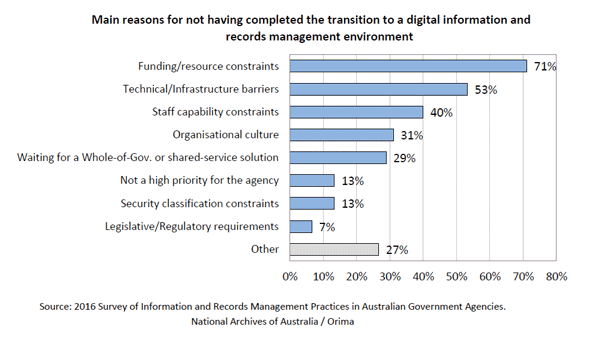Digital Gov delays blamed on dollars and legacy apps
Funding constraints and legacy infrastructure have been cited as the main barrier to Australian government agencies transitioning to digital information management, according to a report by the National Archives of Australia (NAA).
The report was delivered to the Attorney General in August 2016 but has only just been made available on the NAA’s Web site HERE.
It analyses the progress in the Australian’s government’s Digital Continuity 2020 Policy and is based on data self-reported by Commonwealth agencies. According to this, three-quarters of government agencies now manage their records digitally.
The NAA report includes a listing of agencies rated according to their level of maturity in the digital transition, from High (most advanced), Developing to Initial (just beginning their transition).
Some major Commonwealth agencies in the ‘Initial’ stage include; Australian Electoral Commission, Australian Federal Police, Australia Post, Department of Finance, Department of Health, Department of Immigration and Border Protection, Department of Industry, Innovation and Science, Department of Parliamentary Services, and Department of the Prime Minister and Cabinet.
“Although agencies have made progress in digital information management, there is still more that needs to be done”, Archives Director-General David Fricker said.
“The continuing potential for loss of valuable government information is one of our greatest concerns. We are working together with agencies to improve that and assist with their progress towards digital information continuity by 2020”
Some success has been achieved in reducing the costs of storing physical records, according to a comparison of 2015 and 2016 survey results.
Data provided by agencies indicates that substantial improvements in digital information management have been made. In particular,
- A decrease in the cost across the Commonwealth of storing physical records of $A94 million per annum. In 2016 agencies reported the annual cost of storing physical records was $126 million, compared to $220 million in 20104.
- An increase of 44% over 6 years in the number of agencies managing records digitally. In 2016, 74% of agencies reported they had transitioned to digital information management compared to 30% of agencies in 2010. This is consistent with Check-up Digital 2015 data which indicates that 73.9% of agencies are operating digitally by default.

